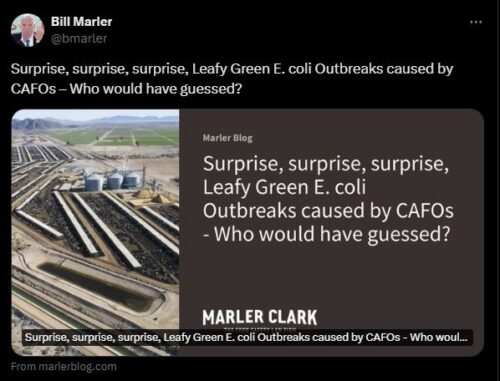I’m addressing graduates of the Johns Hopkins Bloomberg School of Public Health at 9:00 a.m. Information is here. It will be streamed online.
FDA says (quietly) CAFOs contaminate leafy greens
The FDA has issued its boringly titled Southwest Agricultural Region Environmental Microbiology Study (2019 – 2024).
The report seems designed to be boring. Its subject, however, is anything but.
Let me do some translating (in Italics).
- “The study was designed to improve understanding of the environmental factors that may impact the presence of foodborne pathogens in the Southwest agricultural region.” [Leafy greens contaminated with pathogenic bacteria make lots of people really sick, undoubtedly because they come in contact with CAFOs, confined animal feeding operations].
- “Samples were collected from irrigation waters, soil, sediments, air/dust, animal fecal material, wildlife scat, and other sources across approximately a 54 mile (7,000 acres) area of the southwest growing region.” [It’s about time the FDA did this].
- “Special attention was given to the geography of the study region and the types and locations of agricultural and other adjacent and nearby land use activities relative to produce production areas. For example, there is a Concentrated Animal Feeding Operation (CAFO) with more than 80,000 head of cattle and an associated compost operation in proximity to some of the produce production areas studied. [Oh. What a surprise].
The investigation’s findings
- “STEC [Shiga toxin-producing E. coli] can survive in the air and that dust can act as a transfer mechanism for both pathogens and indicator organisms (e.g. generic E. coli) from adjacent and nearby land to water, soil, and plant tissue “[toxic bacteria spread from CAFOs by air and dust].
- “The research team repeatedly observed that generic E. coli concentrations and STEC prevalence and isolation frequency increased as irrigation canal water flowed past an adjacent livestock and compost operation” [toxic bacteria spread from CAFOs by water].
- “…birds and other wildlife do not appear to be significant sources of STEC or E. coli O157:H7 ” [blaming wild birds for contaminating leafy greens is not going to work].
- “STEC strains detected in water, sediment, and plant tissue harvested from our research plots genetically matched strains isolated in air samples providing evidence that bacteria in air can transfer to other locations and surfaces.” [Toxic bacteria get around easily].
The conclusions
Having proven that CAFOs contaminate air, soil, and water with toxic bacteria, the report concludes:
The preliminary results of this study stress the interconnectedness between people, animals and the environment and serve as an important model for how to foster productive dialogue among diverse stakeholders to improve food safety.
Comment
Foster dialogue? They have to be kidding. CAFOs need to be held responsible for the waste produced by their animals. Human wastes are not allowed to be released untreated into the environment; neither should animal wastes.
Here is food safety lawyer Bill Marler’s comment.


